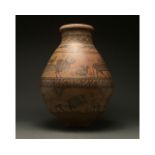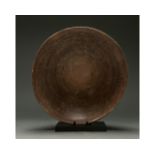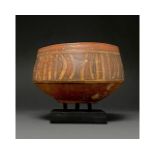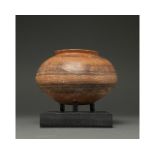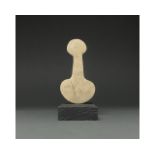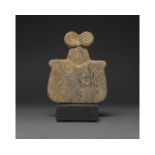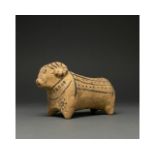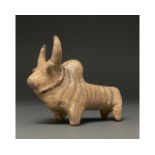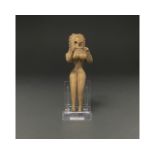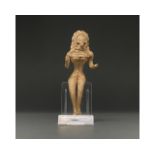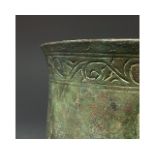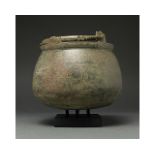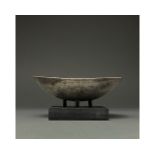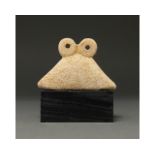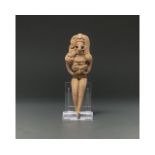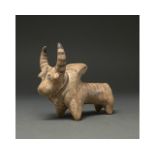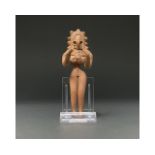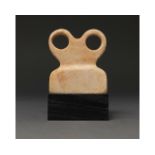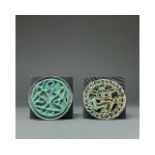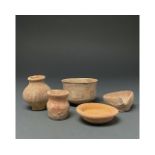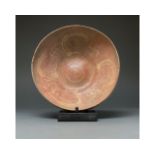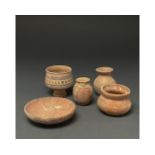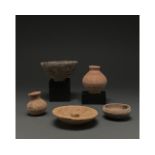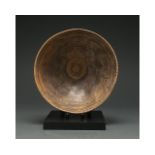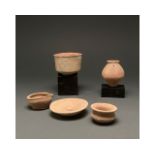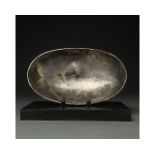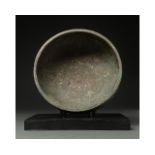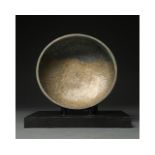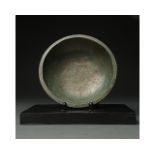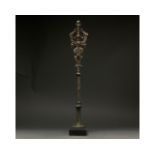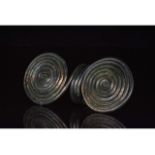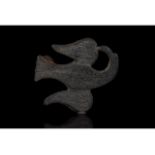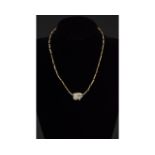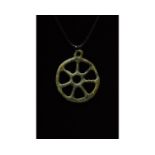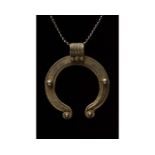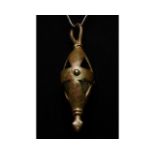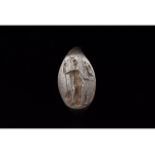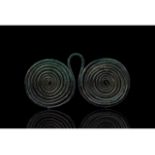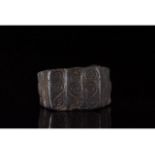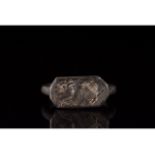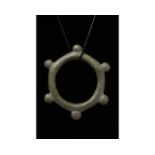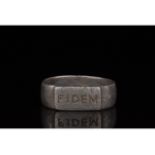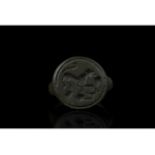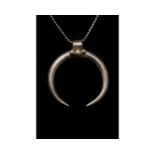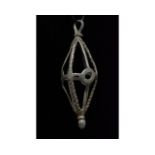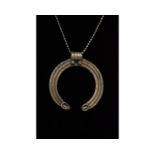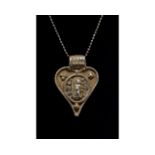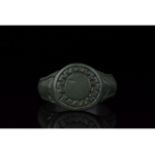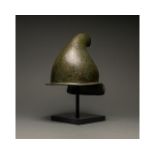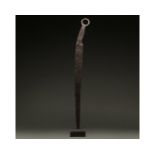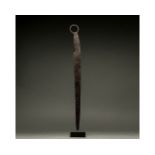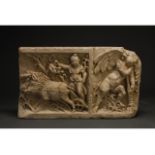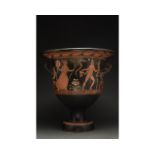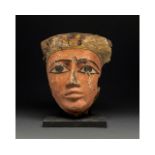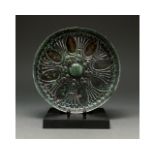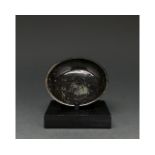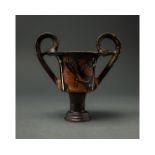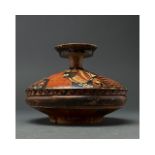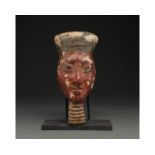Filtered by:
- Category,
- Item Type
- List
- Grid
A subscription to the Price Guide is required to view results for auctions ten days or older. Click here for more information
C. 3rd millennium BC. Indus Valley Civilisation. An polychrome vessel with a globular body, flat base, tapering neck and short outward curving rim...
C. 3rd millennium BC. Indus Valley Civilisation. A large painted bowl with a hemispherical body and ring foot. The bowl, in a terracotta-colour fa...
C. 3rd millennium BC. Indus Valley Civilisation. An ochre-coloured vessel with a globular body, flat base, and short outward curving rim. The exte...
C. 3rd millennium BC. Ancient Central Asia, Indus Valley. A fine example of an polychrome Indus Valley civilisation pot, with globular body a flat...
C. 3rd millennium BC. Ancient Central Asia, Indus Valley. A fine example of an Indus Valley civilisation pot, with globular body a flat, round bas...
2700-2400 BC. Anatolian. A Kusura-type Anatolian idol cream-coloured stone, comprising a rounded body, long neck and sub-circular head. This beaut...
Ca.4000 BC. Western Asiatic. Attractive brown stone Tell Brak Eye Idol consisting of a square body with slight shoulders, a short neck and two inc...
C. 3rd millennium BC. Indus Valley Civilisation. Cream-coloured pottery ram figure with painted black details, curved horns strong, expressive fac...
C. 3rd millennium BC. Indus Valley. An creme-coloured ceramic figurine of a zebu with exaggerated crescent horns, painted with stripes on the horn...
C. 3rd millennium BC. Indus Valley. A lovely buff-coloured handmade fertility idol of characteristically abstract form with delineated legs, curve...
C. 3rd millennium BC. Indus Valley. A lovely buff-coloured handmade fertility idol of characteristically abstract form with delineated legs, curve...
Ca. 1000 BC. Luristani. A stunning bronze vessel with an out-turned rim, slightly tapering neck, truncated conical body and flat base. The exterio...
ca. 1100 AD. Seljuk. A rare bronze situla with a scalloped handle, short, bulging neck, out-flared body and rounded base. The exterior bears an en...
C. 224-651 AD. Sassanian. A silver boat-shaped vessel with a rectangular plan, sloping sides and rounded bottom. The Sassanian empire which ruled ...
Ca.4000 BC. Western Asiatic. Attractive creme coloured stone Tell Brak Eye Idol consisting of a traingular and two circular eyes. Idols of this ki...
C. 3rd millennium BC. Indus Valley. A lovely buff-coloured handmade fertility idol of characteristically abstract form with delineated legs, curve...
C. 3rd millennium BC. Indus Valley. An creme-coloured ceramic figurine of a zebu with exaggerated crescent horns, painted with stripes to the horn...
C. 3rd millennium BC Indus Valley.. A lovely buff-coloured handmade fertility idol of characteristically abstract form with delineated legs, curve...
Ca.4000 BC. Western Asiatic. Attractive brown stone Tell Brak Eye Idol consisting of a square body with slight shoulders, a short neck and two cir...
C. 3rd millennium BC. Ancient Central Asia, Indus Valley. A rare pair of disc-shaped bronze seals with single lug handles on one side. The seal on...
C. 3rd millennium BC. Ancient Central Asia, Indus Valley. A collection of five Indus valley ceramic vessels including (front, L-R): a jar with fla...
C. 3rd millennium BC. Ancient Central Asia, Indus Valley. A fine example of an Indus Valley civilisation painted bowl with a hemispherical body an...
C. 3rd millennium BC. Ancient Central Asia, Indus Valley. A collection of five Indus valley ceramic vessels including (front, L-R): hemispherical ...
C. 3rd millennium BC. Ancient Central Asia, Indus Valley. A collection of five Indus valley ceramic vessels including (front, L-R): bottle with fl...
C. 3rd millennium BC. Ancient Central Asia, Indus Valley. A fine example of an Indus Valley civilisation painted bowl with a hemispherical body an...
C. 3rd millennium BC. Ancient Central Asia, Indus Valley. A collection of five Indus valley ceramic vessels including (front, L-R): a jug with spo...
C. 224-651 AD. Sassanian. A silver boat-shaped vessel with an elliptical plan, sloping sides and rounded bottom. The Sassanian empire which ruled ...
c. 2000-1000 BC, Amlash culture. Bronze bowl with hemispherical body, undulating sides and simple, flattened rim. The sides are decorated with sim...
c. 2000-1000 BC, Amlash culture. Bronze bowl with hemispherical body, undulating sides and simple, flattened rim. The sides are decorated with sim...
c. 550 BC–330 BC, Achaemenid. A rare Western Asiatic bronze bowl featuring a hemispherical body, undulating sides and simple, flattened rim. The...
c. 2000-700 BC. Luristan Culture. A rare Bronze sceptre formed from central tube which terminates in a stylised male head, representing the Master...
BEAUTIFUL BRONZE AGE COILED RING
Ca.800 BC, Bronze Age. A beautiful Celtic bronze ring comprising a coiled wire which forms a circular hoop in the rear and two large circular proj...
C. 100-200 AD, Roman. Silver brooch in the shape of a stylised eagle and a well preserved catchplate. This motif is probably a precursor to the do...
712-30 BC, Late Period/Ptolemaic. A beautiful restrung necklace with creme coloured tubular faience beads and dark coloured discoid faience beads ...
BRONZE AGE WHEEL PENDANT
Ca. 600 BC. Bronze Age. Bronze age wheel pendant comprising circular hoop and crossed spokes. In ancient societies, wheel amulets were traditional...
ROMAN SILVER LUNAR PENDANT
Ca. 100 AD, Roman. Silver lunar amulet comprising a crescent moon with applied silver baubles and a wide banded suspension loop. In Roman mytholog...
BRONZE AGE "CAGE" PENDANT
C. 600 BC, Bronze Age. A large bronze cage pendant. The pendant's biconical shape is formed of a single sheet of bronze with small sections remove...
ROMAN SILVER RING DEPICTING ROMA
C. 100-300 AD. Roman. A silver ring with a D-shaped hoop and flattened, circular plate bezel. The engraved design on the bezel depicts a standing ...
Ca.800 BC, Bronze Age. A beautiful Celtic bronze pendant made from a coiled wire forming two large circular disks. This type is sometimes referred...
100-200 AD. Roman. Heavy silver with circular hoop, wide and ribbed band. The ridged bezel is decorated with a repeating engraved lituus motif. Th...
100-300 AD. Roman. A silver seal ring with a circular hoop and elongated octagonal bezel bearing two engraved, confronted portraits of a man and a...
LARGE BRONZE AGE SUN AMULET
C. 600 BC, Bronze Age European. Openwork bronze sun pendant comprising a single large circle with raised decorative dots at regular intervals on t...
100-300 AD. Roman. A silver ring with a D-shaped hoop and raised, rectangular bezel bearing the inscription “FIDEM.†(“Loyaltyâ€). It is thou...
100-200 AD. Roman. A rare bronze ring with a circular hoop and round plate bezel bearing an engraved scene of a lion (left) attacking a falling hu...
ROMAN SILVER LUNAR PENDANT
Ca. 100 AD, Roman. Silver lunar amulet comprising a crescent moon with applied silver baubles and a wide suspension loop. In Roman mythology, Luna...
BRONZE AGE "CAGE" PENDANT
C. 600 BC, Bronze Age Large bronze cage pendant. The pendant's biconical shape is formed of a single sheet of bronze with small sections removed t...
ROMAN SILVER LUNAR PENDANT
Ca. 100 AD, Roman. Silver lunar amulet comprising a crescent moon made of three strands of silver, two with incesed decorations, applied silver ba...
ROMAN SILVER PENDANT WITH CUPID
100-300 AD. Roman. A silver pendant in the shape of a heart with an applied strap suspension loop with ribbing. The plate is decorated with an app...
100-300 AD, Roman. Ring with circular loop, and raised round bezel bearing an incised decoration comprising a sun motif comprised of two concentri...
Ca. 500-300 BC. Greek Hellenistic period. A bronze Phrygian helment with a conical body and a curved terminus, a flat protruding rim, and a small ...
RARE ANCIENT IRON SICA SWORD
600 BC. European, early Iron Age. An Iron sica sword with a characteristically curved, tapered blade and an integral handle terminating in a loop....
1200-600 BC. European Iron and Bronze Age. An bronze sica sword with a characteristically curved, tapered blade and an integral handle terminating...
100 - 300 AD Roman. A frieze from a marble sarcophagus depicting an intriguing scene in low to high relief from the Calydonian Hunt - the hunt in ...
C. 360 BC. Ancient Greek. A rare red figure terracotta krater with a broad rim, bell-shaped body flanked by two lug handles, and a pedestalled rin...
EGYPTIAN WOODEN MUMMY MASK
664 – 343 B.C. Late Dynastic / Ptolemaic Egyptian. A beautiful wooden mummy mask depicting an individual with ochre-coloured skin, arching black...
c. 323-31 BC. Greek Hellenistic period. A shallow bronze phiale with a broad rim and 7 almond shaped impressions arranged around a central rondel ...
600-330 BC. Western Asiatic, Achaemenid period. This stunning bronze bowl comprises a hemispherical body, flat base, and a flat rim. Bowls like th...
Ca. 340 - 320 BC. South Italian. A stemmed cup with flaring rim, tapering body, pedestalled foot and two high, sweeping ear-shaped handles. The ve...
C. 300 BC. Southern Italian. Beautiful terracotta pyxis comprising lid and bowl. The lid comprises a disk-shaped handle and inverted conical body ...
EGYPTIAN GESSO MUMMY MASK
1070-664 BC. Egyptian, Third Intermediate Period. A beautiful painted mummy mask comprising wooden base coated with gesso and then painted. The ma...

